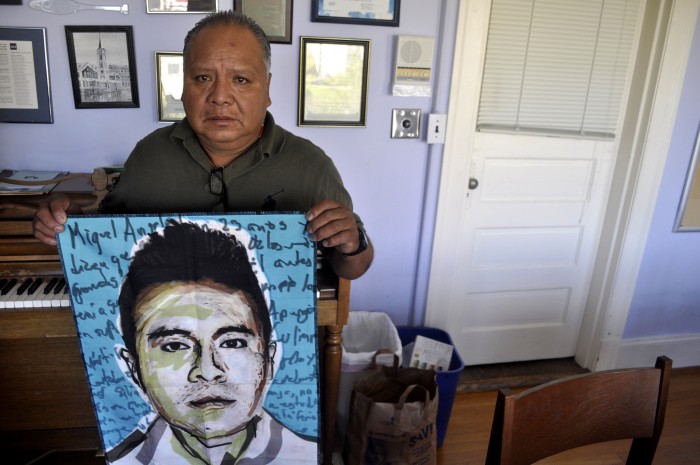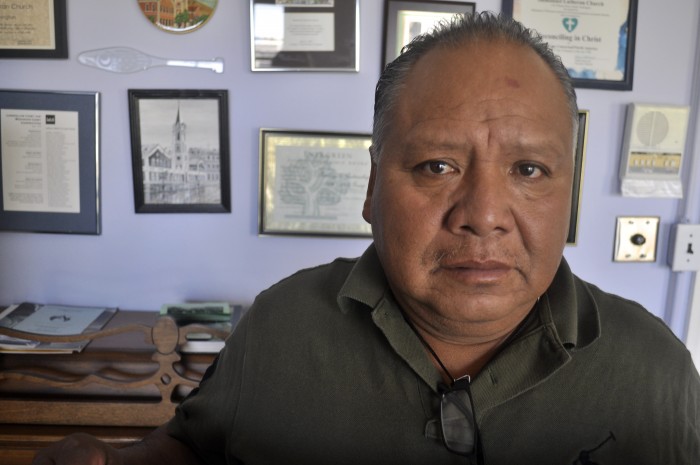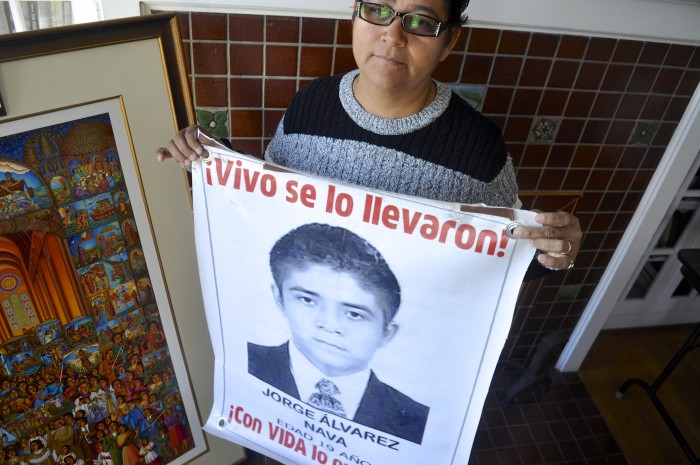
Parents of two of the 43 missing students from a teachers college in Ayotzinapa in Mexico shared their anguish as they made stops in Seattle and Yakima on a U.S. tour seeking support in their calls for renewed investigation.
The Mexican government has closed the case, but members of Caravana43 say a more thorough investigation of the disappearance is needed. They believe the students are still alive and they hope to find the students and hold the culprits responsible.
“Those boys are alive,” said Blanca Luz Nava Vélez, the mother of Jorge Alvarez Nava, 19, and one of the missing Mexican students. “They really want to become teachers and help people.”
Nava, who spoke in Seattle, is traveling with one of three Caravana43 groups touring the United States. They hope to raise awareness of the case in the U.S., and to get supporters to convince U.S. politicians to pressure the Mexican government into reopening the case. Together, the three groups will visit a total of 43 cities in search of solidarity and assistance from the U.S. government and citizens.
“What we’re hoping is for the U.S. government to put pressure on the Mexican government to find a solution for this problem, and to give back the disappeared kids,” said Estanislao Mendoza Chocolate. Mendoza is the father of Miguel Ángel Mendoza Zacarías, 33, another one of the missing students.
The 43 students from Raul Isidro Burgos Normal Rural School of Ayotzinapa have not been seen since Sept. 26 in Iguala, Guerrero, Mexico.
According to reports, the young men were in a group of 100 students from the Normal school who were stopped by Mexican police on their way to protests in Mexico City commemorating the killing of students on Oct. 2, 1968 by Mexican police and military.
“That’s when they were attacked by the police,” Mendoza said. “That’s when the students from Ayotzinapa disappeared.”
While some of the students were injured or killed, the 43 are still unaccounted for.
“Due to the lack of results we see the need to inform Mexican society and the world the hell we live in, the anguish of not knowing where our children are,” wrote Felipe de la Cruz Sandoval, a representative of the parents of the missing students, in a letter explaining the Caravan43 goals.

Investigators from the Mexican government say the former Mayor of Iguala, Jose Luis Abarca, ordered police to detain the students on Sept. 26 in order to prevent the disruption of a speech by his wife, Maria de los Angeles Pineda.
The students were never taken to police stations or jails. Instead, the government reported that they believed the students were handed off to members of the Guerreros Unidos cartel.
Ayotzinapa students say that this is untrue, and say they have seen Guerreros Unidos members with signs saying they were not involved, according to Mendoza. He doesn’t know what to believe.
“That’s why we need more thorough investigation,” Mendoza said. “[Mexico President Enrique] Peña said he was going to investigate — that it didn’t matter who was going to fall. And he hasn’t really done anything till now. He hasn’t fulfilled his promises.”
Nearly seven months after the disappearance, the Mexican attorney general says the case is closed. Abarca and his wife have been arrested and are both facing charges for disappearance of the students and investigators say they recovered a plastic bag of human remains. DNA from the bones matched student Alexander Mora, 19, according to investigators.
“The attorney general wants to close the case having found only one student,” Mendoza said. “And the rest? Where are the rest?”

Questioning the official account
Even before the attorney general declared the case resolved, the parents of the missing students began having doubts about the government’s investigation, and questioned the government’s involvement in the disappearance.
The families had previously hired the Argentine Forensic Anthropology Team (EAAF) when the government had found mass graves and attributed the bodies to the missing students. The EAAF determined that the bodies in the mass graves did not match the DNA of any of the students.
EAAF also investigated the remains from the river and found anomalies.
“The Argentinian forensic investigators said that when they arrived, [the government investigators] already had one of those bags open on the table, and from there they extracted a piece of bone,” said Mendoza, who believes that the government may be involved the students’ disappearance. “There’s no way to know that that bag was actually taken out of the river because nobody witnessed that.”
Based on these samples, EAAF confirmed that Mora’s DNA matched the remains, but no other students’ DNA was found to match. Nonetheless, it was at this point that the attorney general closed the case and stopped searching.
“The Mexican government never really looked for them,” said Nava, Jorge’s mother. “Because if they wanted to, they would have found them very quickly.”
Nava says her son Jorge had attended the Normal school for one month and two weeks when he disappeared with the 43 students.

A smile spreads across Nava’s face as she talks about her son.
“He’s a very joyful person. He likes to study. He loves music. He wanted to study to be a doctor.”
Nava says Jorge couldn’t afford medical school, but still wanted to help people. So he decided to become a teacher and he went to Ayotzinapa. Jorge was very happy to be there, she said.
“My son really wants to continue studying,” Nava said, “because I know he’s alive.”
“Vivos se los llevaron, Vivos los queremos” (“They were taken alive, we want them back alive.”) is a common phrase in the search and protests for these students.
Political pressure
Across Mexico, there are 23,271 missing people. Out of these disappearances, 9,790 have taken place since Peña Nieto began his presidency.
“The problem of people being disappeared in Mexico is big,” Mendoza said. “It’s everywhere. Wherever we go all over the country, that’s the way it is.”
Mendoza says that the U.S. government’s Merida Initiative of 2008 is part of the problem.
The initiative is supposed to fund anti-corruption programs, cross-border telecommunication systems between the U.S. and Mexico, drug treatment court and more in order to rebuild drug afflicted aspects of Mexico, in an attempt to deplete the prominence of cartels, according to the U.S. Department of State. Congress has authorized $2.3 billion to Mexico through this initiative.
But Mendoza says rather than using the money to fight cartels and protect Mexican citizens, the funds are used to suppress citizens and protests. Mendoza believes the money from the initiative funds the killing and kidnapping of people like his son.
Mendoza says people in the U.S. can help by asking Congress to send the Merida initiative money to fund education in Mexico instead.
“There is a need for schools,” Mendoza says. “There are schools that have no roof. There are even classes on the outside. That’s how that money should be used. To teach kids.”

Caravana43 also has heard from students that want to get directly involved and go to Mexico to organize search groups, an idea that Nava supports.
“I would like from here that they would send armies of people to find them,” Nava said.
Mendoza anticipates the Mexican government will attempt to silence Caravana43 and their pursuit of further investigation. But he says that by making their voices heard in the U.S. and around the world in the search for Miguel and the 41 other students, they can hold the government accountable if anything happens to them.
Mendoza does not want his other two sons to get involved.
“They still have a life to live and I’ve already lived,” Mendoza explains. “It’s me and my wife that are fighting, I’m here and she’s in Mexico. Searching.”
These interviews were conducted with the interpretation help of Patricia Vazquez Gomez. To learn more about Caravana43 or to contribute to the tour expenses, visit caravana43.com.


Criminal's students involved with "Los Rojos" gang crew of Guerrero.